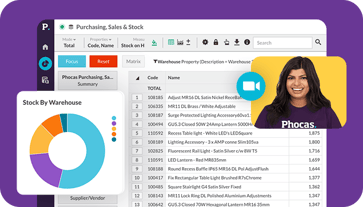How to improve the five types of FP&A planning
Financial planning and analysis (FP&A) provides the insights that drive growth, protect profitability and guide new investments. Done well, FP&A transforms raw financial data into scenario models and forecasts, helping finance leaders and business units move ahead with confidence.
Finance thought leader and educator Christian Wattig has neatly outlined the five types of FP&A planning that form the foundation of the FP&A process. His framework provides an excellent way to think about how finance teams structure their work to support business success.
In this blog, we build on that structure by offering a review of the five types of planning and share practical tips to enhance each one with technology. By applying these approaches, FP&A professionals, CFOs and finance leaders can help their organizations improve financial performance, strengthen financial health and empower business people to feel in control of their data and decision-making.
1. Long-range planning sets the strategic foundation
Long-range planning is also called strategic planning and usually covers a 3–5 year horizon. It serves as the financial backbone of corporate strategy. It sets corporate and business unit performance targets, aligns financial goals with broader strategic ambitions, and provides the confidence that the company can afford to pursue its chosen path.
Without the accurate numbers updated in a BI and FP&A platform, it can be difficult to manage a long range plan. Companies using the right software can visualize and share information easily in meetings allowing finance leaders to openly assess risks, determine mitigation strategies, allocate resources and ensure capital planning is consistent with growth objectives. At its core long-range planning tests whether the strategy is financially viable and provides the direction that will shape annual budgets and operational plans.
Enhancing long-range planning requires collaboration and foresight which is possible when the BI and FP&A platform can consolidate financial and operational data and has secure permission access. Cross-functional involvement is critical in manufacturing and wholesale environments because finance needs the expertise of operations, sales or supply chain to plan effectively. Financial modelling and scenario planning plays a key role here, helping fp&a teams explore high, medium and low scenarios to prepare for uncertainty. Incorporating driver-based modelling and rolling forecasts allows for greater flexibility. By reviewing and refreshing the plan annually, businesses can ensure it remains relevant as market conditions and internal priorities shift.
2. Target setting provides the goals for everyone
Target setting translates the long-term planning into measurable and actionable outcomes. By defining financial targets for profitability, cash flow and growth across branches and teams, businesses create clarity and alignment throughout the organization. These targets motivate teams to perform, serve as the basis for evaluating progress and ensure that financial and operational objectives are linked directly to the company’s overarching strategy. Target setting provides the metrics and KPIs that help everyone understand where they stand and how performance contributes to overall success. When businesses have the BI and FP&A platform to combine multiple sources of data, they can also measure KPIs that are specific to their business which they can benchmark against their industry or compare between branches.
Targets should be SMART—specific, measurable, achievable, relevant, and time-bound—to ensure accountability and impact. Communicating them clearly is just as important as setting them; dashboards and data visualization can help finance leaders bring targets to life in a way that resonates across the company.
According to Mike Morgan, Managing Director at Savona Food Services, once the businesses started to visualize and share targets in dashboards people wanted to see them every day and the consistent measurement helped them reach targets more consistently.
Well-designed targets create alignment and give every business unit a sense of ownership in the pursuit of strategic goals.
3. Forecasting the market ahead
Financial forecasting gives business people the agility to anticipate what lies ahead, typically covering a period of 12 to 18 months. Using historical data, operational trends and market intelligence help FP&A professionals predict outcomes for revenue, expenses and cash flow. Forecasting also provides a platform to model the financial impact of different decisions and allows finance leaders to assess risks proactively. Forecasting also helps to make informed decisions throughout the financial year and to compare expected outcomes with budgets and targets.
Improving forecasting often happens when teams add a BI and FP&A platform that integrates up-to-date sales and purchasing data and supports driver-based modelling. Rolling forecasts are possible, ensuring businesses can update their outlook frequently as market conditions change, rather than being tied to an outdated annual view. Incorporating machine learning and predictive analytics may further improve forecast accuracy by detecting patterns that humans might miss.
4. Annual budgeting outlines the game plan
The annual budget or operating plan links strategies with tactics for the business. It converts strategic objectives into detailed financial statements. The budget covers revenue, expenses the balance sheet and the cash flow statement while also allocating resources across departments and projects. Unlike forecasts which can morph, the annual budget represents a fixed commitment or the standard against which performance is measured. Through variance analysis, businesses can compare actual results against the budget to identify gaps, uncover root causes and drive corrective actions.
In this way, the budget not only guides day-to-day decisions but also serves as a tool for accountability across the finance department and business units.
Enhancing annual budgeting requires tying it closely to strategic priorities so that every line item reflects the company’s goals. Collaboration is vital and inviting department heads into the process early helps build ownership and accountability. FP&A software like Phocas is built for this style of connected planning and allows finance teams to hand over the budget to the department to add confidential and specific information. At the same time, the BI and FPA platform can automate and consolidate data inputs which allows for more detail to be included, reduce reliance on manual spreadsheets and accelerate reporting. Effective budgeting is about producing a disciplined yet flexible framework that helps businesses remain agile while staying true to their commitments.
5. External guidance builds trust with stakeholders
External guidance is where FP&A planning connects with what's happening across the business from sales to the warehouse. It also involves sharing financial expectations with investors and regulators, so businesses are transparent and compliant while operating effectively. External guidance takes the outputs of the annual budget and presents realistic projections of sales, margins and profitability. For finance leaders and CFOs, external guidance is more than a regulatory requirement but a great opportunity to build trust and credibility with everyone in the business.
Guidance should be aligned with internal forecasts and business performance, but it should also be presented in ranges to allow for uncertainty. Finance leaders can use the BI and FP&A platform to consistently report across the business. Perhaps most importantly external guidance is about helping everyone to do better and contribute to the overall goals of the business.
A BI and FP&A platform that integrates with your ERP can improve the entire business planning process. It connects all your financial and operational data that drives all the other FP&A tasks so people across the business can share their expertise, agree to targets and be part of the shared success.


Katrina is a professional writer with a decade of experience in business and tech. She explains how data can work for business people and finance teams without all the tech jargon.
Related blog posts
If you’re nodding along to this headline, you’re probably interested in finding out how this process can be made reliable and repeatable. Many finance teams need spreadsheets, email trails and offline files to make critical adjustments before reports are ready for the business. It works until it doesn’t. As complexity grows, the gap between your ERP and the final ‘true’ management view widens.
Read more
Asahi Group (a large beverage manufacturer and distributor) recently experienced a cyberattack that didn’t destroy the business, but did create the kind of operational and financial mess most mid-market companies recognize. Orders couldn’t be processed normally, shipments were delayed, call centres were disrupted and some products became temporarily hard to get in retail and hospitality channels. The impact showed up quickly in results. Domestic sales dropped materially for a period while systems were restored and workarounds were put in place.
Read more
Intercompany journals are like transferring stock between two warehouses in the same distribution group. One warehouse records inventory going out at as an internal transfer price, and the other records it coming in. The group hasn’t gained or lost anything — it’s just tracking the internal movement.
Read more
Finance departments in mid-market companies are planning more. Why? Because the market is volatile and competitive, and to stay profitable and keep customers coming back, business planning has become mandatory.
Read moreBrowse by category

Find out how our platform gives you the visibility you need to get more done.
Get your demo today